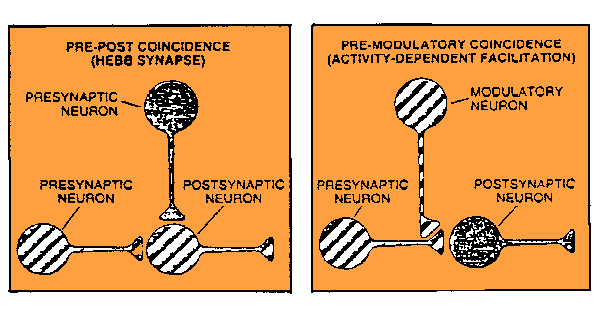Difference between revisions of "NeuralNetworksResearch"
(Automated page entry using MWPush.pl) |
|||
| (One intermediate revision by the same user not shown) | |||
| Line 1: | Line 1: | ||
| − | |||
<pre style="color: green">Neural Network Research</pre> | <pre style="color: green">Neural Network Research</pre> | ||
@@[[Home]] -> [[NeuralNetworksResearch]] | @@[[Home]] -> [[NeuralNetworksResearch]] | ||
| Line 15: | Line 14: | ||
Theory of neural networks, besides of just explaining how the mind operates on lower level of details, should provide computational models to enable reproducing biological neural networks with IT methods. | Theory of neural networks, besides of just explaining how the mind operates on lower level of details, should provide computational models to enable reproducing biological neural networks with IT methods. | ||
| − | == New Theory of Neural Networks == | + | == New Theory of Neural Networks == |
New theory of neural networks should cover at least: | New theory of neural networks should cover at least: | ||
| Line 29: | Line 28: | ||
* '''neural networks''' as multi-connector structures, not just input and output, but allowing input side to become output side, have secondary inputs and outputs for specific purposes, support two different networks be totally connected by all their neurons (e.g. neurons and interneurons) | * '''neural networks''' as multi-connector structures, not just input and output, but allowing input side to become output side, have secondary inputs and outputs for specific purposes, support two different networks be totally connected by all their neurons (e.g. neurons and interneurons) | ||
| − | + | == Research Targets == | |
| − | + | ||
| − | + | ||
| − | + | ||
| − | + | ||
| − | + | ||
| − | + | ||
| − | + | ||
| − | + | ||
| − | + | ||
| − | == Research Targets == | + | |
* [[NeuronResearch|What is the Neuron]] | * [[NeuronResearch|What is the Neuron]] | ||
Latest revision as of 19:08, 28 November 2018
Neural Network Research
@@Home -> NeuralNetworksResearch

Neural Network research covers new theory of neural networks.
Unfortunately, existing theory has been started 50 years ago and was mostly occupied by mathematicians who contribute to the theory without good understanding of new findings of biological sciences.
As a result we have large building of formulas and theorems, with a weak fundament of previous-century knowledge of neural networks. This building is unable to scale solved tasks, to explain human memory and features, it is mostly dedicated to so called "weak intelligence" - fitting Turing definition - it produces things that to some extent, in laboratory conditions, look like being intelligent, whilst it is just good mistification.
Theory of neural networks, besides of just explaining how the mind operates on lower level of details, should provide computational models to enable reproducing biological neural networks with IT methods.
New Theory of Neural Networks
New theory of neural networks should cover at least:
- neuron types - pyramidal, stellate (there are total of 150 different types on neurons)
- neuron structure - e.g. pyramidal neuron consists of soma, 1 (exactly one) apical dendrite, set of distal dendrites, set of proximal dendrites, and one axon, which has 2 (exactly two) branches
- neuron development - with enlightning and enforcement of dendrite to axon connectivity, which is like weights in classical neural networks
- neuron assemblies - grouping neurons in low-level structures which enable to build items of long-term memory
- neurotransmitters - that provide positive, negative and modulation connections, which combined with multi-receptor dendrites able to build several different networks on the same set of neurons
- glia cells - which fill the space in between neurons, feed them, direct their development and are brokers between excitatory and inhibitory neurotransmitters
- types of inter-neuron connectivity - axon-to-axon, axon-to-soma, axon-to-dendrite
- signal transmission - action potential, membrane (pre-synaptic) potential, post-synaptic potential, different signal timing, and non-firing intervals for inhibitory, excitatory and modulatory neurotransmitters
- neural networks as multi-connector structures, not just input and output, but allowing input side to become output side, have secondary inputs and outputs for specific purposes, support two different networks be totally connected by all their neurons (e.g. neurons and interneurons)
Research Targets
- What is the Neuron
- Neuron Connections
- Glial Cells
- Neural Signal Transmission
- Building Neural Networks
Interesting links
- Neurons, glia, neurotransmitters - see link

- Neuron Types - see link

Useful resources
# Neural Networks in Plain English # [Network FAQ by SAS] # FANN library # NN Lections